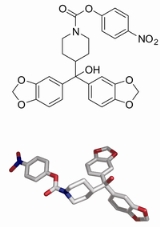
JZL184
Encyclopedia
JZL184 is an irreversible inhibitor
for monoacylglycerol lipase
(MAGL), the primary enzyme
responsible for degrading the endocannabinoid 2-arachidonoylglycerol
(2-AG). It displays high selectivity for MAGL over other brain
serine hydrolase
s, including the anandamide
-degrading enzyme fatty acid amide hydrolase (FAAH), thereby making it a useful tool for studying the effects of endogenous 2-AG signaling, in vivo. Administration of JZL184 to mice was reported to cause dramatic elevation of brain 2-AG leading to several cannabinoid-related behavioral effects
.
Enzyme inhibitor
An enzyme inhibitor is a molecule that binds to enzymes and decreases their activity. Since blocking an enzyme's activity can kill a pathogen or correct a metabolic imbalance, many drugs are enzyme inhibitors. They are also used as herbicides and pesticides...
for monoacylglycerol lipase
Monoacylglycerol lipase
Monoacylglycerol lipase, also known as MAG lipase, MAGL, MGL or MGLL is a protein that, in humans, is encoded by the MGLL gene. MAGL is a 33-kDa, membrane-associated member of the serine hydrolase superfamily and contains the classical GXSXG consensus sequence common to most serine hydrolases...
(MAGL), the primary enzyme
Enzyme
Enzymes are proteins that catalyze chemical reactions. In enzymatic reactions, the molecules at the beginning of the process, called substrates, are converted into different molecules, called products. Almost all chemical reactions in a biological cell need enzymes in order to occur at rates...
responsible for degrading the endocannabinoid 2-arachidonoylglycerol
2-Arachidonoylglycerol
2-Arachidonoylglycerol is an endocannabinoid, an endogenous agonist of the CB1 receptor. It is an ester formed from the omega-6 fatty acid arachidonic acid and glycerol. It is present at relatively high levels in the central nervous system, with cannabinoid neuromodulatory effects. It has been...
(2-AG). It displays high selectivity for MAGL over other brain
Brain
The brain is the center of the nervous system in all vertebrate and most invertebrate animals—only a few primitive invertebrates such as sponges, jellyfish, sea squirts and starfishes do not have one. It is located in the head, usually close to primary sensory apparatus such as vision, hearing,...
serine hydrolase
Serine hydrolase
The serine hydrolase superfamily is one of the largest known enzyme families comprising approximately ~200 enzymes or 1% of the genes in the human proteome. A characteristic defining feature of this superfamily is the presence of an active site nucleophilic serine that is used for the hydrolysis of...
s, including the anandamide
Anandamide
Anandamide, also known as N-arachidonoylethanolamide or AEA, is an endogenous cannabinoid neurotransmitter. The name is taken from the Sanskrit word ananda, which means "bliss, delight", and amide. It is synthesized from N-arachidonoyl phosphatidylethanolamine by multiple pathways...
-degrading enzyme fatty acid amide hydrolase (FAAH), thereby making it a useful tool for studying the effects of endogenous 2-AG signaling, in vivo. Administration of JZL184 to mice was reported to cause dramatic elevation of brain 2-AG leading to several cannabinoid-related behavioral effects
Tetrad test
The tetrad test is a series of behavioral paradigms in which rodents treated with cannabinoids such as THC show effects. It is widely used for screening drugs that induce cannabinoid receptor-mediated effects in rodents. The four behavioral components of the tetrad are spontaneous activity,...
.

